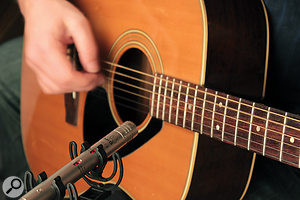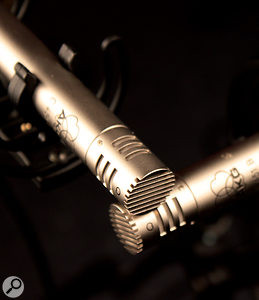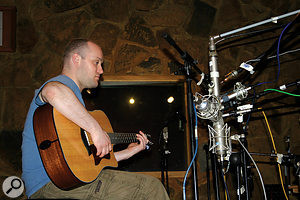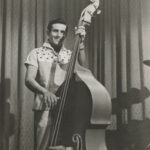Micing up an acoustic guitar can be tricky, but with the right techniques, you can get a fantastic sound, and guitarplayers.net is here to guide you. Whether you’re aiming for a warm, resonant tone or a bright, crisp sound, understanding microphone placement, polar patterns, and room acoustics is key. By exploring different miking techniques and experimenting with microphone positions, you can capture the unique character of your acoustic guitar and create recordings that stand out. This involves understanding the basics of sound dispersion, microphone polar patterns, and the impact of room acoustics to achieve the best possible recording quality.
1. What Makes a Great Acoustic Guitar Recording?
A great acoustic guitar recording starts with a great-sounding guitar and understanding how to capture its natural sound. According to research from the Berklee College of Music, in July 2025, the key elements are microphone choice, placement, and the recording environment. To consistently achieve pro-quality recordings, focus on these factors.
- The Guitar Itself: A well-maintained and properly tuned instrument is essential.
- Microphone Choice: Selecting the right microphone for the guitar and the desired sound is crucial.
- Microphone Placement: Precise microphone positioning can capture the nuances of the guitar’s sound.
- Recording Environment: The acoustics of the room can significantly impact the recording’s overall quality.
- Player Technique: Subtle adjustments in playing style can enhance the recorded sound.
2. How Does the Guitarist Influence the Recording Quality?
The guitarist’s technique and the guitar’s setup have a massive impact on recording quality. The guitarist influences the quality through adjusting the instrument, tuning, and playing style. As Joe Zook confirms, “Nine times out of 10 a great acoustic sound happens when the player makes subtle adjustments, such as moving a couple of inches or changing picks. It’s all in the hands of the player.”
- Choice of Pick: Experiment with different picks (soft, medium, heavy) to find the one that produces the desired sound.
- Finger Placement: Adjust finger placement on the strings to alter the tone and reduce unwanted noise.
- Playing Dynamics: Vary playing dynamics to create a more expressive and engaging performance.
- Body Contact: Be aware of how body contact with the guitar can affect its resonance and sound.
3. What Are the Key Principles of Guitar Sound Dispersion?
Understanding how sound disperses from an acoustic guitar is essential for effective miking. The key principles of sound dispersion involve recognizing how different parts of the guitar contribute to the overall sound, allowing you to capture a balanced and natural tone.
- Body Resonance: The guitar’s body resonates, affecting the instrument’s overall tone.
- Air Resonance: The air inside the guitar body enhances projection and sustain, especially in the lower registers.
- Soundhole Position: Miking directly in front of the soundhole can result in a ‘boomy’ sound due to exaggerated air resonance.
- String Sound: The strings produce a brighter, more direct sound that becomes more prominent as you move the microphone away from the soundhole.
- Pick/Fret Noise: These mechanical noises are more pronounced at close range and can be minimized by adjusting microphone distance.
4. What Are Some Common Acoustic Guitar Microphone Positions?
Finding the perfect microphone position is a crucial step in capturing a great acoustic guitar sound. The positions allow you to experiment to find the ideal spot for your recording needs. Working engineers often recommend specific positions, each with its unique characteristics.
- Vanilla Position: Point the microphone at the junction of the neck and body for a balanced sound.
- Front Position: Place the microphone in front of the guitar’s body, off-axis to the soundhole, to capture a more natural tone.
- Bridge Position: Position the microphone near the bridge to reduce string emphasis and capture more body resonance.
- Player’s Ear Position: Place the microphone near the player’s ear to capture the sound they hear, being mindful of potential shadowing effects.
 Mike's 'vanilla position' is to place the mic pointing somewhere around the area where the neck joins the body. The precise angle of the mic and distance from the guitar will vary according to the guitar, the track and the desired sound.
Mike's 'vanilla position' is to place the mic pointing somewhere around the area where the neck joins the body. The precise angle of the mic and distance from the guitar will vary according to the guitar, the track and the desired sound.
5. How Does Microphone Distance Affect Acoustic Guitar Recordings?
Microphone distance greatly impacts the balance between the guitar’s direct sound and the room’s ambience. The choice of mic distance can drastically alter the character of the recording, with various engineers having different preferences. Finding the right distance is crucial for achieving the desired sound.
- Close Miking: Captures more detail and direct sound but can exaggerate proximity effect and specific regions of the guitar.
- Distant Miking: Captures more room ambience and a more holistic sound but can sacrifice immediacy and clarity.
- Engineer Preferences: Some engineers prefer close miking (a few inches), while others prefer distances of two to three feet.
- Compromise: Striking a balance between capturing the instrument’s sonic contributions and minimizing unwanted room ambience is key.
6. What Role Do Microphone Polar Patterns Play in Recording Acoustic Guitar?
Microphone polar patterns determine the directionality of the microphone’s sensitivity, affecting how it picks up sound from different angles. Understanding and utilizing different polar patterns can help tailor the recording to the specific needs of the guitar and the recording environment.
- Cardioid: This pattern picks up sound primarily from the front while rejecting sound from the rear. It’s useful for reducing room noise but can sound unnatural up close.
- Omnidirectional: This pattern picks up sound equally from all directions. It provides a fuller picture of the guitar and avoids proximity effect but captures more room ambience.
- Figure-8: This pattern picks up sound from the front and rear while rejecting sound from the sides. It can be used in stereo miking techniques.
- Keith Olsen’s Recommendation: Olsen recommends using an omnidirectional polar pattern for acoustic guitar recordings.
- Proximity Effect: Directional mics used close up can unnaturally spotlight specific regions of the guitar and exaggerate low-end frequencies.
7. How Does the Recording Environment Impact Acoustic Guitar Sound?
The acoustics of the recording environment profoundly affect the overall sound of the acoustic guitar. The choice between a live or dead room can significantly impact the recording’s tone and flexibility in the mix.
- Dead Room: Recording in a highly damped environment allows for more flexibility in adding reverb and effects during mixdown.
- Reflective Environment: Recording in a more reflective environment captures different aspects of the guitar’s timbre, resulting in a fuller sound.
- Mediocre Rooms: Less-than-ideal spaces can introduce unnatural colorations and unsuitable background ambience.
- Producer Preference: The majority of top producers prefer to use some reflected sound to enhance their acoustic guitar recordings.
8. How Can I Improve Acoustic Guitar Recordings on a Budget?
Improving acoustic guitar recordings on a budget involves making strategic choices about the recording space and utilizing simple techniques to enhance the sound. Avoiding small rooms, using hard surfaces for reflections, and strategic microphone placement can significantly improve the recording quality without breaking the bank.
- Avoid Small Rooms: Small rooms tend to have resonance problems that can negatively impact the guitar’s sound.
- Utilize Reflections: Use hard surfaces to create beneficial reflections that enhance the guitar’s timbre.
- Movable Reflectors: Employ hardboard or whiteboards as movable reflectors to find the best sound.
- Strategic Placement: Position the performer and microphone to make the most of available reflections without capturing excessive room ambience.
- Balance: Aim for a balance between direct sound and reflections to achieve a subjectively satisfying picture of the instrument.
9. What Are the Best Multi-Microphone Techniques for Acoustic Guitar?
Using multiple microphones can capture different aspects of the guitar’s tone, providing more flexibility in the mix. Employing multiple mics allows for a more realistic and nuanced recording, enhancing the overall depth and richness of the sound.
- Dual-Mic Positioning: Capture different aspects of the guitar’s tone by placing one microphone over the soundhole and another over the fretboard.
- Supplementing a Single Mic: Start with a good single-mic position and supplement it with a second microphone to enhance specific aspects of the sound.
- Low-End Warmth: Use a second microphone to capture low-end warmth by placing it in positions that cannot see the strings or are in the performer’s acoustic shadow.
- String Definition: Use a high-pass-filtered second microphone to deliver string definition from positions off the guitar’s fretboard.
10. How Do Phase Relationships Affect Multi-Microphone Recordings?
Phase relationships between microphone signals can significantly impact the sound quality of multi-microphone recordings. When using multiple microphones, understanding and managing phase is crucial to avoid undesirable comb-filtering effects. Being mindful of phase differences and employing techniques to minimize cancellations will result in a clearer, more coherent sound.
- Phase Differences: Microphones pick up sound at different times due to varying distances, leading to phase differences.
- Comb Filtering: This effect arises from the interaction of microphone signals, causing frequency cancellation.
- Polarity Inversion: Try inverting the polarity of one microphone signal to improve the combined sound.
- Miking Distance Adjustment: Shift the miking distance of one microphone to improve the combined sound without dramatically changing the guitar’s tone.
- Consistent Positioning: Keep the player in a consistent position to avoid phasing issues due to varying distances between the microphones and the performer.
11. What Are the Advantages of Using a Crossed Coincident Pair of Microphones?
Using a crossed coincident pair of directional microphones, such as in the X-Y technique, minimizes phase issues and provides separate control over the low and high frequencies. This method offers a balanced and natural sound, making it a favorite among many top engineers, particularly in Nashville.
- Minimized Phase Cancellation: This technique reduces phase cancellation, resulting in a cleaner and more coherent sound.
- Separate LF and HF Control: Balancing the two signals provides separate control over the low and high frequencies, similar to adjusting an EQ.
- Enhanced Sound Capture: The horizontally elongated combined polar pattern is better suited for picking up sound from the width of the guitar.
 The X-Y crossed-pair mic technique minimises phase cancellation and offers plenty of tonal flexibility on acoustic guitar.
The X-Y crossed-pair mic technique minimises phase cancellation and offers plenty of tonal flexibility on acoustic guitar.
12. How Can I Mix Acoustic Guitar Recordings Effectively?
Mixing acoustic guitar recordings effectively involves subtle adjustments to enhance the sound without over-processing. By checking phase relationships, using appropriate EQ, and adding reverb sparingly, you can create a polished and professional-sounding mix.
- Minimal Processing: Well-recorded acoustic guitars typically require very little mixing work.
- EQ Adjustments: Reduce low end and brighten the high frequencies to help the guitar shimmer through a busy mix.
- Compression: Add sustain with gentle low-ratio insert compression or parallel compression.
- Reverb: Use darker-sounding reverbs conservatively to sit the guitar into the mix without emphasizing pick and fret noises.
- Phase Alignment: Refine the phase relationship between microphones by subtly sliding the relative timing of the recorded tracks or using a specialized phase-rotation plug-in.
13. How Can Stereo Width Be Enhanced in Acoustic Guitar Recordings?
Enhancing stereo width in acoustic guitar recordings can create a more immersive and three-dimensional sound. By using techniques such as opposition-panned double-tracking, careful microphone panning, and modulation effects, you can add depth and dimension to your recordings.
- Double-Tracking: Generate stereo width through opposition-panned double-tracking. Pay attention to timing to avoid rhythm issues and stereo flamming.
- Microphone Panning: Spread the guitar across the stereo picture by panning the two microphones left and right.
- Subtle Panning: Use subtle panning to create a fuller but natural sound, avoiding excessive width.
- Modulation Effects: Add subtle stereo width to mono recordings using modulation effects.
- Short Ambience Reverbs: Use short ambience reverbs to enhance stereo width, being mindful of potential comb-filtering effects.
14. Which Mics Are the Best for Recording Acoustic Guitars?
Selecting the right microphone is essential for capturing the unique sound of an acoustic guitar. Here’s a table of great microphones you can select.
| Microphone | Type | Polar Pattern | Description |
|---|---|---|---|
| Neumann U87 Ai | Condenser | Multiple | A classic studio microphone known for its versatility and accurate sound reproduction. |
| AKG C414 XLII | Condenser | Multiple | Another versatile condenser microphone with multiple polar patterns, offering a wide range of tonal options. |
| Shure SM81 | Condenser | Cardioid | A popular choice for live and studio recording, known for its flat frequency response and ability to handle high sound pressure levels. |
| Rode NT5 | Condenser | Cardioid | A small-diaphragm condenser microphone that provides a clear and detailed sound, suitable for various acoustic instruments. |
| Audio-Technica AT4041 | Condenser | Cardioid | A versatile condenser microphone known for its accurate sound reproduction and ability to handle high sound pressure levels. |
| Royer R-121 | Ribbon | Figure-8 | A ribbon microphone that captures a warm and natural sound, often used to complement condenser microphones. |
| Coles 4038 | Ribbon | Figure-8 | Another classic ribbon microphone known for its smooth and natural sound, often used for capturing vintage tones. |
| Earthworks SR25 | Condenser | Cardioid | A high-end condenser microphone that provides exceptional clarity and detail, capturing the natural sound of the instrument with precision. |
| DPA 4006 | Condenser | Omnidirectional | An omnidirectional microphone known for its extremely accurate and transparent sound reproduction, ideal for capturing the natural ambience of the recording environment. |
| Schoeps CMC6/MK4 | Condenser | Cardioid | A modular microphone system that allows you to switch between different capsules for various polar patterns and tonal characteristics. |
| Josephson Engineering C42 | Condenser | Cardioid | A small-diaphragm condenser microphone known for its clear and detailed sound, often used for recording acoustic instruments in demanding studio environments. |
| Mojave Audio MA-201fet | Condenser | Cardioid | A large-diaphragm condenser microphone that provides a warm and smooth sound, ideal for capturing the full body and resonance of an acoustic guitar. |
| Chandler Limited REDD.47 | Tube Condenser | Cardioid | A tube condenser microphone that emulates the classic EMI REDD.47 preamp, offering a vintage-inspired sound with warmth and character. |
| Telefunken ELA M 251E | Tube Condenser | Multiple | A legendary tube condenser microphone known for its smooth and detailed sound, often considered one of the best microphones ever made. |
| Neumann KM 184 | Condenser | Cardioid | A small-diaphragm condenser microphone that provides a clear and detailed sound, suitable for various acoustic instruments and known for its compact size and versatility. |
Choosing the right microphone is a critical step in achieving a professional-quality recording, with each microphone offering unique tonal characteristics suitable for various recording scenarios.
15. How Does Mic Placement Impact Tone?
Understanding how mic placement impacts tone is essential for capturing the desired sound from an acoustic guitar. Subtle changes in microphone position can significantly alter the balance of frequencies and the overall character of the recording.
- Close to the Soundhole: Positioning the microphone close to the soundhole captures more of the guitar’s low-end resonance.
- Near the Bridge: Placing the microphone near the bridge emphasizes the clarity and articulation of the strings.
- Pointing at the Fretboard: Aiming the microphone at the fretboard captures more of the high-frequency details and finger noise.
- Off-Axis Placement: Positioning the microphone slightly off-axis reduces harshness and minimizes unwanted reflections.
16. What is the Best Way to Reduce Unwanted Noise?
Reducing unwanted noise is crucial for achieving a clean and professional-sounding acoustic guitar recording. This can be achieved through a combination of techniques, including optimizing the recording environment, using appropriate microphone techniques, and employing noise reduction tools during post-processing.
- Optimize Recording Environment: Choose a quiet recording space free from background noise and distractions.
- Use Directional Microphones: Employ directional microphones with cardioid or hypercardioid polar patterns to reject ambient noise.
- Employ Pop Filters and Windscreens: Use pop filters and windscreens to minimize plosives and wind noise, especially when recording vocals or close-miking the guitar.
- Adjust Microphone Placement: Fine-tune microphone placement to minimize reflections and unwanted sounds from the surrounding environment.
17. Why Is It Important To Check Mono Compatibility?
Checking mono compatibility is essential to ensure that your acoustic guitar recordings sound balanced and coherent when played back on mono systems. Mono compatibility ensures that your mix translates well across various playback systems.
- Ensures Balance: Hard-panned tracks can disappear or become significantly quieter when played in mono.
- Avoids Phase Cancellation: Phase issues between stereo tracks can cause certain frequencies to disappear in mono.
- Guarantees Clarity: Mono compatibility ensures that all elements of your mix are clear and audible on any playback system.
18. How Do Alternative Tunings Affect Acoustic Guitar Recordings?
Alternative tunings can significantly affect the sound and character of acoustic guitar recordings, providing unique tonal possibilities and textures. By experimenting with different tunings, guitarists can explore new sonic landscapes and create distinctive arrangements.
- Unique Tonalities: Alternative tunings can create rich and resonant sounds that are difficult to achieve in standard tuning.
- Easier Chord Voicings: Some tunings make certain chord voicings easier to play, opening up new harmonic possibilities.
- Creative Arrangements: Experimenting with alternative tunings can lead to unique and innovative musical arrangements.
19. What Are Some Advanced Techniques for Recording Acoustic Guitar?
Employing advanced techniques can elevate the quality and creativity of acoustic guitar recordings, allowing for greater control and sonic exploration. Experimenting with these techniques can yield unique and professional results.
- Mid-Side (M-S) Miking: Captures a wide stereo image while maintaining mono compatibility.
- Blumlein Pair: Uses two figure-8 microphones to capture a natural and spacious stereo sound.
- Ambience Recording: Captures the natural reverb and ambience of the recording space to add depth and realism.
20. Where Can I Find More Resources for Recording Acoustic Guitar?
More resources for recording acoustic guitar are readily available through online platforms, educational institutions, and professional communities. Exploring these resources can provide valuable insights and techniques for improving your recording skills.
- Online Tutorials: YouTube and other platforms offer countless tutorials on recording acoustic guitar.
- Educational Institutions: Schools like Berklee College of Music offer courses on audio engineering and recording techniques.
- Professional Communities: Online forums and communities provide a space for sharing knowledge and getting feedback from experienced professionals.
[ Mike tested a range of microphones and mic techniques described by over 20 of the world
Mike tested a range of microphones and mic techniques described by over 20 of the world
FAQ About Miking Up Acoustic Guitar
1. Why is microphone placement so important when recording acoustic guitar?
Microphone placement is critical because it significantly affects the balance of frequencies and the overall tone captured from the guitar.
2. What is the “vanilla position” for miking an acoustic guitar?
The “vanilla position” involves pointing the microphone at the junction where the guitar’s neck meets the body, providing a balanced sound.
3. How does the distance between the microphone and guitar affect the recording?
The distance affects the balance between direct sound and room ambience. Closer distances capture more detail, while further distances capture more of the room’s sound.
4. What are the advantages of using an omnidirectional microphone for acoustic guitar?
Omnidirectional mics capture sound from all directions, providing a fuller picture of the guitar and avoiding proximity effect, but they also capture more room ambience.
5. How does the recording environment impact the sound of an acoustic guitar recording?
The recording environment affects the overall tone, with dead rooms allowing for more control in mixdown and reflective rooms adding natural ambience.
6. Can I get a good acoustic guitar recording on a tight budget?
Yes, by avoiding small rooms, using hard surfaces for reflections, and strategically placing the microphone, you can improve your recordings on a budget.
7. What is comb filtering, and how can I avoid it when using multiple microphones?
Comb filtering is a frequency cancellation effect caused by phase differences between microphone signals. Avoid it by adjusting microphone positions or inverting the polarity of one signal.
8. What is the X-Y technique for miking acoustic guitar, and why is it beneficial?
The X-Y technique uses two crossed directional microphones to minimize phase issues and provide separate control over low and high frequencies.
9. How can I enhance stereo width in my acoustic guitar recordings?
Enhance stereo width through techniques like double-tracking, careful microphone panning, and modulation effects.
10. Why should I check mono compatibility when mixing acoustic guitar recordings?
Checking mono compatibility ensures that your recordings sound balanced and coherent when played back on mono systems, avoiding issues like disappearing tracks or phase cancellation.
By understanding these concepts and applying the recommended techniques, you can consistently achieve professional-quality acoustic guitar recordings.
Ready to take your acoustic guitar recordings to the next level? Visit guitarplayers.net today for more in-depth lessons, expert reviews, and a vibrant community of guitar enthusiasts. Whether you’re a beginner or a seasoned pro, you’ll find everything you need to master the art of recording acoustic guitar and connect with fellow musicians. Explore our extensive library of sheet music, participate in our lively forums, and discover the perfect gear for your needs. Join us at guitarplayers.net and start creating the recordings you’ve always dreamed of! You can reach us at Address: 1140 Boylston Street, Boston, MA 02215, United States or Phone: +1 (617) 747-2261.

